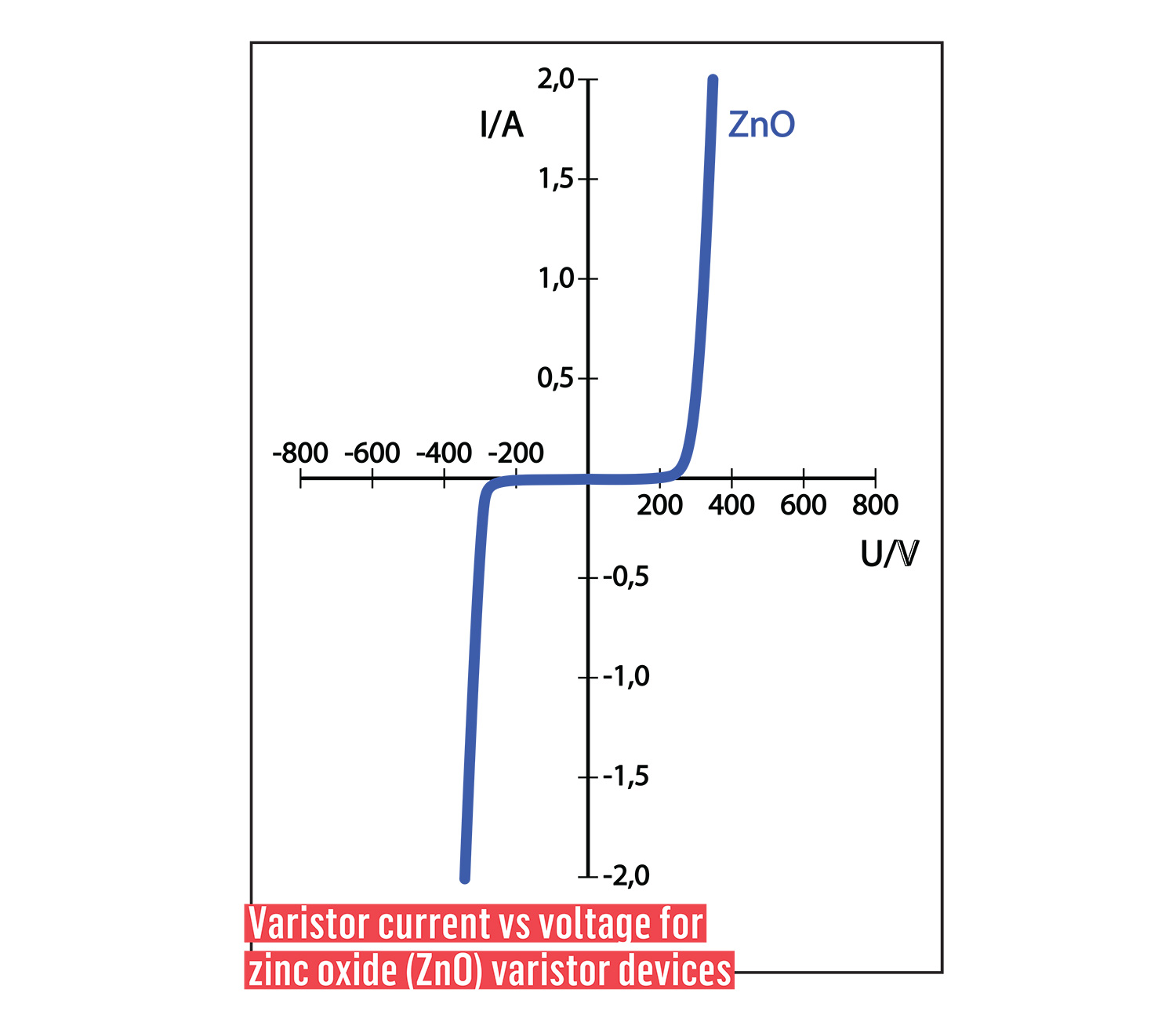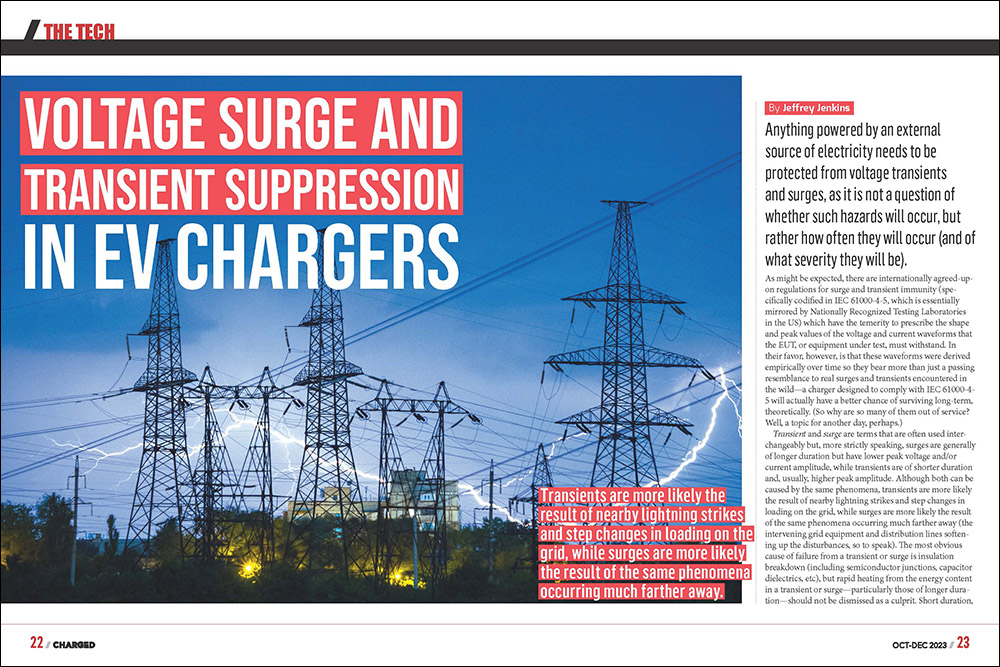[ad_1]
Something powered by an exterior supply of electrical energy must be shielded from voltage transients and surges, as it’s not a query of whether or not such hazards will happen, however somewhat how usually they’ll happen (and of what severity they are going to be).
As may be anticipated, there are internationally agreed-upon rules for surge and transient immunity (particularly codified in IEC 61000-4-5, which is actually mirrored by Nationally Acknowledged Testing Laboratories within the US) which have the temerity to prescribe the form and peak values of the voltage and present waveforms that the EUT, or tools below take a look at, should stand up to. Of their favor, nevertheless, is that these waveforms had been derived empirically over time so that they bear greater than only a passing resemblance to actual surges and transients encountered within the wild—a charger designed to adjust to IEC 61000-4-5 will even have a greater probability of surviving long-term, theoretically. (So why are so lots of them out of service? Properly, a subject for an additional day, maybe.)
Transient and surge are phrases which can be usually used interchangeably however, extra strictly talking, surges are usually of longer length however have decrease peak voltage and/or present amplitude, whereas transients are of shorter length and, often, larger peak amplitude. Though each might be attributable to the identical phenomena, transients are extra probably the results of close by lightning strikes and step adjustments in loading on the grid, whereas surges are extra probably the results of the identical phenomena occurring a lot farther away (the intervening grid tools and distribution strains softening up the disturbances, so to talk).

The obvious explanation for failure from a transient or surge is insulation breakdown (together with semiconductor junctions, capacitor dielectrics, and so forth), however speedy heating from the power content material in a transient or surge—notably these of longer length—shouldn’t be dismissed as a perpetrator. Quick length, high-voltage transients with low power content material—one thing alongside the strains of a static electrical energy discharge, let’s say—can create pinhole failures in insulation (particularly the silicon dioxide dielectric in built-in circuits) that incrementally enhance the possibility of complete failure afterward, whereas higher-energy transients—comparable to from an oblique lightning strike or a big motor being disconnected from the grid—can open up main breaches within the insulation and even trigger outright arcing, each of which are usually extra instantly deadly. In distinction, surges often trigger tools failure extra from extreme heating in protecting parts (the irony!) somewhat than outright dielectric breakdown in capacitors, semiconductors, and so forth. Regardless, it’s the power content material in a transient or surge that finally causes failure, and so a surge with a comparatively modest peak voltage/present amplitude however which lasts many tens of milliseconds may very well be simply as damaging as a better peak amplitude transient that solely lasts just a few tens of microseconds.
Transients are extra probably the results of close by lightning strikes and step adjustments in loading on the grid, whereas surges are extra probably the results of the identical phenomena occurring a lot farther away.
Though it’s not sensible to totally harden an digital machine in opposition to a direct lightning strike with peak amplitudes within the 100s of megavolts and kiloamperes vary, the possibilities of such taking place are additionally vanishingly distant, fortuitously (even right here in Florida). Lightning extra generally impacts the grid not directly when it strikes a ways away by inducing currents onto the entire distribution strains equally—or in frequent mode, as in comparison with between phases or scorching and impartial, which is regular mode. Consequently, surge suppression positioned between the section conductors for cover in opposition to step load adjustments gained’t do a lick of fine in opposition to common-mode transients or surges, as they require protecting parts between the section conductors (together with impartial, if current) and earth floor. Thus, it’s mandatory to handle each common- and normal-mode phenomena individually, particularly because the electrical security rules that tools should additionally adjust to restrict the quantity of leakage present between the section conductors(s) and floor. This, as we’ll quickly see, can place some severe restrictions on the forms of protecting parts that can be utilized, particularly when the inevitable common-mode filter is factored in for complying with EMC, or ElectroMagnetic Compatibility, necessities (which is itself one more complicating issue).
Surge suppression positioned between the section conductors for cover in opposition to step load adjustments gained’t do a lick of fine in opposition to common- mode transients or surges
The opposite frequent supply of transients//surges on the grid is a step change in loading. The obvious instance of that is when a motor is switched on or off. The surge present drawn throughout turn-on shops power within the inductance of the distribution community, and that is launched as soon as the motor comes up to the mark. Different examples are automated reclosers ({the electrical} distribution time period for a circuit breaker) trying to re-energize a line that may have been solely briefly overloaded and faucet changers on substation transformers that compensate for adjustments in loading downstream. The overwhelming majority—if not all—of the surges from step adjustments in load include a comparatively modest peak voltage (in comparison with lightning, anyway) however which are inclined to final for longer durations of time as a result of L/R (that’s, inductance over resistance) time constants concerned.
There are three important methods to take care of transients/surges: blocking, clamping and “crowbarring.” Blocking transients and surges might be completed with sequence inductance and/or shunt capacitance—or a low-pass filter, in different phrases—and as this occurs to explain the common-mode filter ubiquitously employed to fulfill EMC necessities in something with a switchmode energy converter, mentioned filter is an integral a part of the transient safety scheme (whether or not by intent or accident). The common-mode filter will probably be far much less efficient (arguably ineffective, even) in opposition to surges, nevertheless, and electrical security necessities restrict the quantity of shunt capacitance between the section conductor(s) and floor (to restrict the quantity of steady leakage present injected into floor by them), which additionally limits its potential effectiveness. Moreover, the insulation on the common-mode filter’s parts may not be sufficiently strong to face as much as repeated overvoltage themselves, so it may go from offering safety to needing it.
There are three important methods to take care of transients/surges: blocking, clamping and “crowbarring.”
Clamping and crowbarring are associated technique of shunting transient/surge power—which basically means changing it to warmth. The primary distinction is {that a} clamp holds regular close to its breakdown voltage when conducting, whereas the voltage throughout a crowbar drops to a low worth as soon as it begins conducting. Clamping gadgets robotically reset after a surge occasion, then, however have to resist extraordinarily excessive peak wattages (from the product of their excessive breakdown voltage and the surge present). Crowbar gadgets can deal with a lot larger surge power by advantage of their comparatively low breakdown voltage—leading to a decrease peak wattage when multiplied by the surge present—however as a result of that breakdown voltage is far decrease than the “holdoff” voltage when not conducting, they won’t “reset” till the upstream energy is interrupted (both by a swap—or, extra generally—a fuse opening up).

By far the commonest element used for cover in opposition to transients and surges is the MOV, or Steel Oxide Varistor, primarily as a result of it’s each efficient and really low cost to fabricate (the cynic in me says the latter is much extra vital…), as it’s principally a compacted chunk of zinc oxide particles. MOVs are clamping gadgets that don’t (or shouldn’t—extra on that under) conduct any present till a sure voltage is exceeded, at which level their efficient resistance drops in an try (key phrase, that) to maintain the voltage throughout them fixed on the breakdown worth. The decrease the dynamic resistance throughout clamping, the nearer the clamping voltage will probably be to the breakdown voltage, and the much less instantaneous energy dissipated throughout clamping, all of which provides as much as higher safety and longer operational life. As these objectives are achieved by utilizing a bigger quantity MOV, nevertheless, there’s a sensible restrict to how a lot optimizing might be completed right here. One other consideration hinted at earlier is that MOVs have a restricted operational lifetime (measured in joules of complete power clamped), as a result of their leakage present will increase after every surge occasion—that’s, they do enable some present to go by means of them when they need to be off, and that present will increase every time a MOV is known as upon to do its job. Precise finish of life happens when the leakage present is sufficiently excessive to trigger overheating from its steady energy dissipation (somewhat than the instantaneous dissipation sustained throughout a surge occasion), which might be somewhat extra thrilling than anticipated if mentioned overheating ends in a fireplace. One resolution is to wire a MOV in sequence with a crowbar-type machine because the latter have a tendency to higher block leakage present when not triggered into conduction, whereas the MOV will robotically reset the crowbar after the surge occasion has handed.
One other sort of clamping machine is the Transient Voltage Suppressor diode, or TVS, which is a semiconductor machine constructed equally to a Zener diode, besides that it’s optimized for peak present dealing with somewhat than the steadiness of its breakdown voltage. TVS diodes can be found in bidirectional variations appropriate to be used in AC circuits, however they’re much more generally deployed on DC provide strains the place their extra correct clamping voltage is a plus and their decrease power ranking isn’t a lot of a minus.

Crowbar protecting gadgets embrace one of many oldest in addition to one of many latest applied sciences: the GDT, Fuel Discharge Tube, and the “gateless” thyristor (e.g. SIDACTor by Littelfuse), respectively. The GDT is successfully a spark hole, consisting of two or extra electrodes inside a sealed tube. When a sufficiently excessive voltage is impressed upon any two electrodes, an arc will kind, at which level the voltage drop plummets to 30 V or much less. This—and the intrinsically strong building of the GDT—permits it to deal with very excessive peak currents, however one main draw back is a comparatively gradual response time resulting in an unpredictable triggering voltage. Consequently, GDTs are hardly ever utilized by themselves (notable exception: within the previous POTS or Plain Previous Phone System). These shortcomings are addressed within the gateless thyristor, which is a 4-layer (i.e. pnpn) semiconductor machine that turns a bug of the traditional gated thyristor right into a characteristic: triggering into conduction when an overvoltage is utilized throughout its important current-carrying terminals. Gateless thyristors are a lot sooner than GDTs, might be designed to set off at a a lot decrease (and far more constant) voltage, and exhibit a good decrease voltage drop when in conduction (<10 V). On the flip aspect, they’ve a far decrease peak energy (and power) dealing with functionality from each a unit quantity and value foundation in comparison with a GDT.
A Degree 1 charger plugged right into a residential outlet has to fulfill much less stringent circumstances than a Degree 2 charger wired on to a breaker panel in a industrial constructing or a DC quick charger wired on to a 3-phase distribution transformer.
The final consideration is proximity to the grid (aka “publicity” or “class” degree). Nearer proximity experiences worsening transient/surge circumstances. Thus, a Degree 1 charger plugged right into a residential outlet has to fulfill much less stringent circumstances than a Degree 2 charger wired on to a breaker panel in a industrial constructing or a DC quick charger wired on to a 3-phase distribution transformer. In some respects, the upper energy dealing with that usually goes together with nearer proximity to the grid naturally affords extra immunity to transients and surges, however don’t make the error of assuming the identical dimension MOV or GDT, and so forth, will probably be as much as the problem all over the place!
This text initially appeared in Difficulty 66: October-December 2023 – Subscribe now.
[ad_2]


